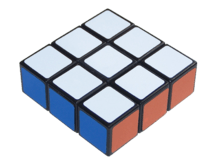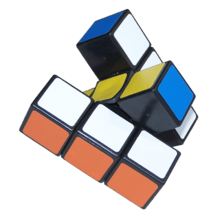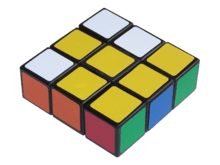Floppy Cube
The Floppy Cube[1] is a cuboidal twisty puzzle in the style of the Rubik's Cube. It was originally invented by Katsuhiko Okamoto and mass-produced by Gentosha Toys,[1] although several other companies have since mass-produced it as well.



Overview
The Floppy Cube is essentially a 1x3x3 Rubik's Cube: it is made up of 9 identical cubic pieces arranged into a 1x3x3 cuboid.[1]
The puzzle consists of 4 corner pieces, 4 edge pieces and 1 centre piece. Each corner piece has four colours each, each edge piece has three colours each, while the centre piece has two colours (on the opposite faces). The puzzle can be thought of as twisting around its edge pieces - each twist causes one edge piece to rotate 180° in place, and the two adjacent corner pieces to swap positions (while also being rotated).
The purpose of the puzzle is to scramble the colours, and then restore it to its original state of having one colour per face.
Number of combinations
There are 4 edge pieces, each of which can be twisted into two different orientations, independently of the other edge pieces. Therefore, the edges can be orientated in 24 different ways. They cannot be permutated. There are also 4 corner pieces, which can be permutated in 4! different ways. They cannot be flipped; their orientation is fully determined by their location. The whole puzzle also has a parity constraint: the parity of the corner permutation is the same as the parity of the number of flipped edges. This divides the full number by 2.
The full number of possible combinations on the Floppy Cube is therefore:[1]
In relative terms, this number is extremely low compared to other puzzles like the Rubik's Cube (with over 43 quintillion combinations),[2] the Rubik's Domino (which has just under 410 million combinations),[3] or the Pocket Cube (with over 3.6 million combinations).[4]
God's Number
As explained above, the total number of possible configurations of the Floppy Cube is 192, which is sufficiently small to allow a computer search for optimal solutions. The table below summarises the result of such a search, stating the number p of positions that require n twists to solve the puzzle:[1]
| n | 0 | 1 | 2 | 3 | 4 | 5 | 6 | 7 | 8 | Total |
|---|---|---|---|---|---|---|---|---|---|---|
| p | 1 | 4 | 10 | 24 | 53 | 64 | 31 | 4 | 1 | 192 |
The above table shows that the puzzle is always at most 8 twists away from its solved state (i.e. its God's Number is 8). Similarly to the total number of combinations, this number is very low compared to the Rubik's Cube (20),[2] the Rubik's Domino (18)[3] and, to some extent, the Pocket Cube (11).[4]
The table also shows that there is only one combination that is exactly 8 moves away from the solved state; this is the combination in which all the corners are in their correct places but all the edges are flipped (analogous to the superflip on the Rubik's Cube).[1]
Super Floppy Cube
The Super Floppy Cube (often shortened to Super Floppy)[5] is a common variant of the Floppy Cube. It was also invented by Katsuhiko Okamoto[5] but several versions have also been produced by other companies.
The key difference between this puzzle and the Floppy Cube is that the Floppy Cube is restricted to only 180° rotations (i.e. an edge piece cannot be twisted 90°), while the Super Floppy Cube does allow edges to rotate 90°. This in turn allows the corner pieces to move to locations above and below the edge pieces and thus change the shape of the puzzle.[5]
There is also a subtle difference between the original version of the puzzle and the version mass-produced by other companies. The original puzzle has an internal mechanism which prevents an isolated edge piece from turning - i.e. an edge piece may only twist if there is at least one corner piece adjacent to it. The mass-produced version does not feature this mechanism, which allows edge pieces to twist "on their own" - causing the puzzle to be considerably easier.[5]
Number of combinations
The four edge pieces now have 4 orientations each on the Super Floppy Cube (compared to the Floppy Cube's 2); therefore, the edges can now be orientated in 44 different ways. However, the edges still cannot be permutated.
There are now 12 different locations that the four corner pieces could be located in (up from 4); this means they can now be permutated in 12!/(12-4)! different ways. The corners still cannot be flipped; their orientation continues to be fully dependent on their position.
All of these positions are attainable: there is no parity constraint, regardless of whether the edge pieces can twist on their own or not.
The full number is therefore:[5]
This number is significantly larger than the number of combinations on the Floppy Cube. The God's Number for this puzzle is also considerably larger than that of the Floppy Cube: 13 (when edges can twist on their own) or 15 (when they cannot).[5]
References
- Floppy Cube - Jaap's Puzzle Page
- God's Number is 20
- Rubik's Domino - Jaap's Puzzle Page
- 2x2x2 Rubik's Cube - Jaap's Puzzle Page
- Super Floppy - Jaap's Puzzle Page
